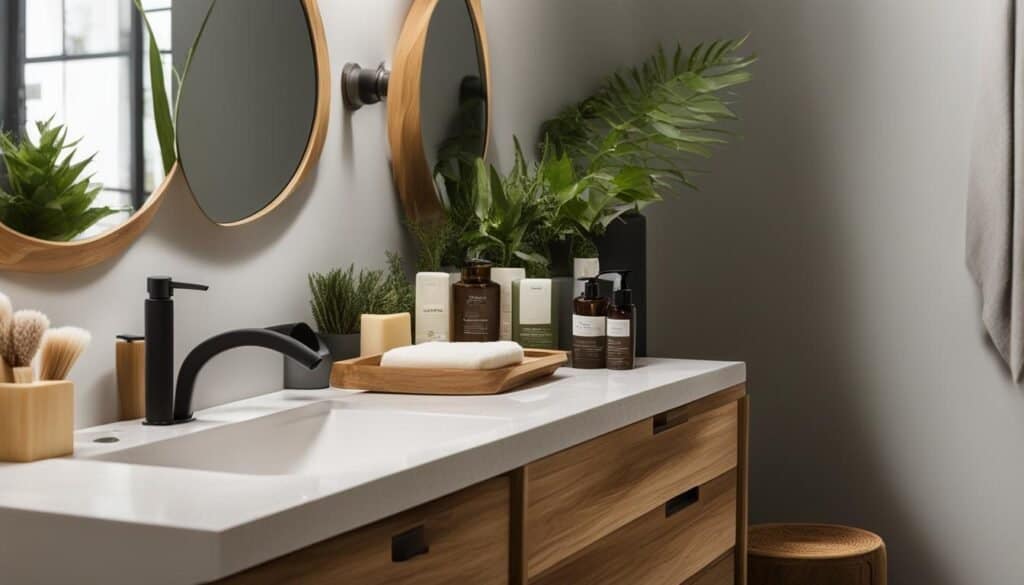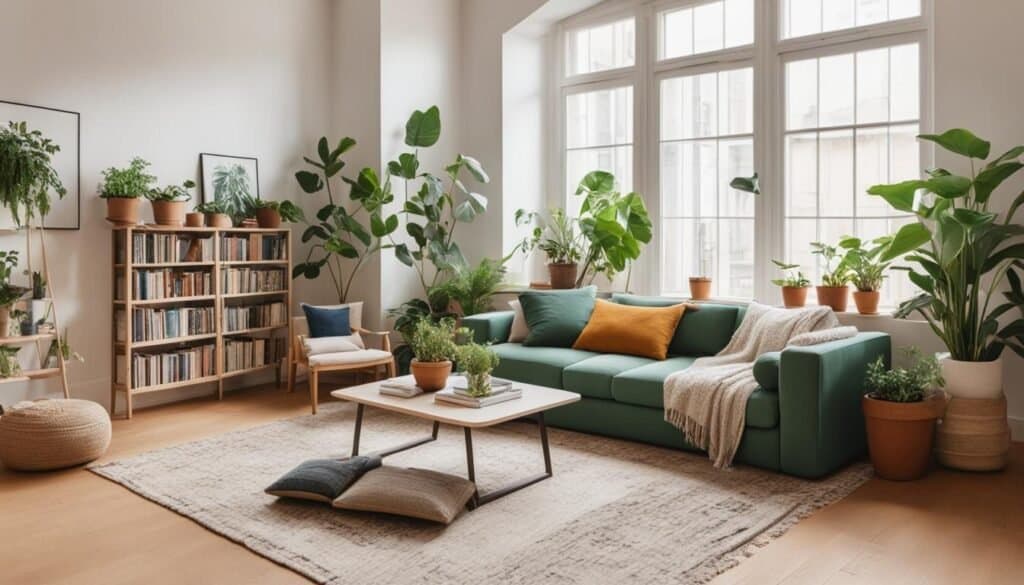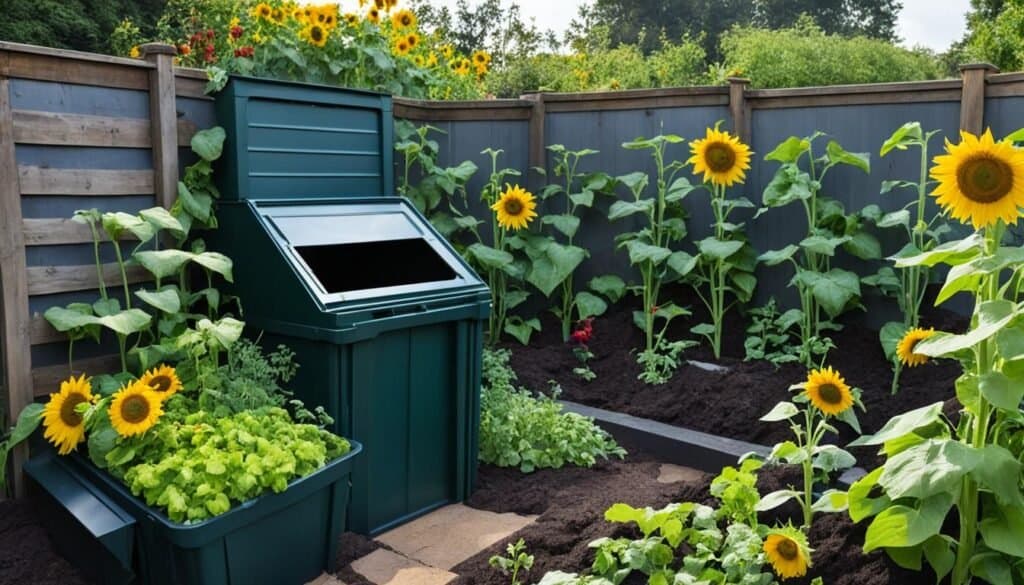


As we witness the increasing urgency to protect our planet and preserve its natural resources, it’s essential to adopt a more eco-friendly and sustainable living approach. One significant way we can make a difference is by incorporating eco-friendly and biodegradable household items into our daily lives.
Table of Contents
These products are designed to break down quickly, helping to reduce waste and preventing damage to our environment. By choosing household items made from plant-based materials, we can promote zero waste cleaning, minimize landfills, and decrease our reliance on single-use plastic and harsh chemicals. In this guide, I will share 51 eco-friendly and biodegradable items that can help you lead a greener, more carbon-neutral lifestyle.

The bathroom may be a smaller space within the home, but it holds ample opportunity for green innovation. Swapping traditional plastic toothbrushes for biodegradable toothbrushes, using shampoo bars, and adopting silicone menstrual cups can drastically cut down on bathroom waste.
Tools like bamboo toilet brushes and natural sponges crafted from cellulose or coconut fiber make for an equally effective and more sustainable cleaning arsenal. Moreover, investing in refillable containers for toiletries emphasizes the value of reusing resources over contributing to single-use waste, paving the way for a zero waste bathroom routine that aligns with an environmentally responsible lifestyle.
Incorporating eco-friendly toiletries and organic personal care products into your daily routine helps to significantly reduce the environmental impact of your bathroom habits.
By implementing these products and practices, you can create a greener and more sustainable bathroom routine, benefiting both your personal wellbeing and the environment.
| Eco-friendly Product | Description |
|---|---|
| Biodegradable Toothbrushes | Made of bamboo, these toothbrushes are compostable and sustainable. |
| Organic Personal Care Products | These products feature natural ingredients and eco-friendly packaging to reduce waste. |
| Shampoo Bars | Solid shampoo bars eliminate the need for plastic bottles and offer a zero-waste alternative. |
| Silicone Menstrual Cups | A reusable alternative to disposable feminine products, these cups save money and reduce waste. |
| Bamboo Toilet Brush | A sustainable and eco-friendly alternative to plastic toilet brushes. |
| Natural Sponges | Made from cellulose or coconut fiber, these sponges are an eco-friendly option for bathroom cleaning. |
| Refillable Containers | Using refillable containers for toiletries reduces single-use waste and emphasizes reusing resources. |

Curating a sustainable living space is essential for reducing our environmental footprint and ensuring a healthier home environment. By choosing eco-friendly furniture and decorations made from recycled materials, incorporating energy-efficient bulbs, and embracing green electronics, we can transform our living spaces into eco-friendly havens. In this section, we’ll explore sustainable decorating and green electronics that can help you create a sustainable interior design.
Sustainable decorating begins with selecting materials that have minimal environmental impact. Opt for furniture crafted from sustainably harvested wood or recycled materials, ensuring a lower carbon footprint and a more eco-friendly living space. When choosing rugs, curtains, and other soft furnishings, look for items made from organic materials, such as cotton, hemp, or bamboo. These materials are not only eco-friendly but also add a touch of nature and comfort to your living space.
Remember to avoid products containing VOCs (volatile organic compounds) and opt for water-based, low-VOC paints for your walls to ensure a healthy air quality within your living space.
Saving energy is not only good for the environment, but it also helps reduce household expenses. Switch to energy-efficient bulbs, such as LED or CFL bulbs, which consume less power and last longer than traditional incandescent bulbs. Green electronics, including appliances and devices with ENERGY STAR ratings, can significantly reduce your home’s electricity consumption.
Consider integrating solar energy systems and water catchment solutions into your home design, further promoting the use of renewable energy sources and water conservation.
To create the ultimate sustainable living space, invest in air purification technologies, such as air purifiers and houseplants. Houseplants offer a natural way to clean indoor air and add a pleasant, relaxing touch to your home.
| Eco-friendly Furniture Materials | Energy-efficient Lighting Options | Green Electronics Features | Air Purification Techniques |
|---|---|---|---|
| Reclaimed Wood | LED Bulbs | ENERGY STAR Appliances | Air Purifiers |
| Bamboo | CFL Bulbs | Smart Thermostats | Houseplants |
| Recycled Metal | Smart Lighting Systems | Energy-saving Power Strips | HEPA Filters |
Creating a sustainable living space encompasses mindful choices in furniture, decorations, lighting, and electronics. By incorporating these eco-friendly and biodegradable household items, you’ll contribute to a more sustainable and healthier living environment for you and your family.

Creating a sustainable bedroom not only benefits the environment, but also improves your overall sleep hygiene and well-being. With the right combination of eco-friendly bedding, mattresses, and furniture crafted from natural, biodegradable materials, you can foster a cleaner, healthier sleep environment.
One of the best ways to enhance your sleep quality is by opting for organic cotton bedding and organic wool blankets. These natural materials are not only soft and comfortable but also free from harmful chemicals and toxins. By choosing organic, you foster a non-toxic sleep environment that can significantly improve the quality of your rest, making you feel refreshed when you wake up.
Investing in eco-friendly mattresses and sustainable furniture can lead to a greener, healthier bedroom. Natural materials like latex, organic cotton, and sustainably sourced wood offer excellent alternatives to traditional, non-sustainable options. By making eco-conscious choices that prioritize health and sustainability, you can create a bedroom that caters to your needs without compromising the well-being of our planet.
Transitioning to a sustainable bedroom is achievable through careful selection of organic beddings, eco-friendly mattresses, and durable furniture made from natural materials. Incorporating these elements into your space not only allows you to enjoy a cleaner and healthier sleep environment but also supports long-term environmental goals, ultimately contributing to a greener future for generations to come.

Transforming your outdoor space into a sustainable garden is an enriching way to embrace nature’s rhythms. Implementing organic gardening principles, composting and rainwater harvesting systems, as well as eco-friendly landscaping ideas, can help create an outdoor haven with minimal environmental impact. With a focus on outdoor sustainability, you can enjoy a beautiful garden that nourishes both your soul and the planet.
One of the foundational aspects of an eco-friendly garden is organic gardening. By avoiding synthetic pesticides and fertilizers, you help maintain soil health and reduce water pollution. You can further enhance your sustainable garden by incorporating composting. Composting kitchen waste and landscaping debris not only reduces landfill contributions but also adds valuable nutrients back into the soil, promoting plant health and vibrancy.
Through green outdoor practices, the sustainable garden becomes an oasis that supports vital ecosystems and harmonizes with nature’s wonders.
Another sustainable gardening practice is rainwater harvesting. By collecting and storing rainwater, you can irrigate your plants with an eco-friendly water source, conserving precious potable water resources. Pairing rainwater harvesting with drought-tolerant or native plants amplifies its benefits and further promotes water conservation.
An integral part of eco-friendly landscaping is the use of plant-based garden tools and materials. Opting for tools made from durable, biodegradable materials like bamboo and wood can help reduce your garden’s plastic consumption and overall environmental impact.
When designing a sustainable garden, it’s essential to consider the biodiversity of your space. Incorporating pollinator-friendly plants like lavender, bee balm, and coneflowers attracts bees, butterflies, and other essential pollinators that help maintain vital ecosystems. Encouraging biodiversity not only enlivens your garden with a colorful array of flora and fauna but also fosters a thriving ecosystem that all species can enjoy.
| Garden Element | Eco-Friendly Choices |
|---|---|
| Plant selection | Drought-tolerant, native plants and pollinator-friendly species |
| Water conservation | Rainwater harvesting systems, drip irrigation, and mulching |
| Composting | Reusable bins and tumblers or simple DIY compost piles |
| Garden tools | Bamboo, wood, and other plant-based materials |
| Pest control | Organic, chemical-free options such as companion planting and neem oil |
By enriching your outdoor space with sustainable garden practices, you are actively fostering a lifestyle that respects and harmonizes with the natural world. Embracing eco-friendly landscaping and green outdoor practices, you contribute to a more sustainable future while enjoying a gorgeous, environmentally responsible haven right in your backyard.

Conscious shopping habits are crucial for reducing our carbon footprint. Embracing eco-friendly shopping practices not only benefits the environment but also encourages sustainable purchasing decisions. By adopting reusable bags, sustainable containers, and plastic-free products, we can actively participate in environmental stewardship and help combat climate change.
One of the easiest and most impactful ways to adopt eco-conscious shopping habits is to use reusable bags and containers. Rather than relying on single-use plastic bags, opt for durable, washable bags made from natural fibers like cotton or jute. These eco-friendly alternatives significantly reduce the amount of plastic waste entering our landfills and oceans. Likewise, utilizing sustainable containers made from materials like glass, stainless steel, or silicone for food storage and on-the-go meals can help minimize the demand for disposable plastic containers.
Making sustainable purchasing decisions involves considering the lifecycle of products, including their materials and manufacturing processes. Opting for items that have a lesser environmental impact is an investment in a healthier world. Look for products that are made from sustainably sourced, biodegradable materials or recycled content. Prioritize purchasing from businesses that demonstrate a commitment to sustainability, such as those offering certified B Corp products or adhering to fair trade principles.
Moreover, adopting green consumer choices can extend beyond the products we purchase. For example, buying local produce reduces transportation emissions, and supporting brands that implement sustainable packaging contribute to overall carbon footprint reduction.
Ultimately, each sustainable shopping decision contributes to a larger narrative of environmental stewardship and proactive efforts to combat climate change. By integrating eco-friendly practices into our daily lives, we are collectively fostering a future where sustainability is the norm.
In conclusion, exploring the vast array of eco-friendly and biodegradable household items available today can inspire a significant shift towards a more sustainable living. Each eco-conscious choice we make, whether it’s selecting products made from bamboo, organic cotton, or simply incorporating more plant-based ingredients, contributes to reducing our environmental impact. Embracing a green lifestyle not only benefits our planet but also transforms our daily living into a more environmentally responsible experience.
Environmental stewardship goes beyond the products we use; it’s about fostering a mindset that appreciates the interdependence between our daily lives and the health of our planet. As we champion sustainability throughout our homes, we acknowledge the pressing need to protect our environment for future generations. Making small, but consistent eco-conscious choices significantly contributes to a larger collective effort in combating climate change and preserving natural resources.
From investing in energy-efficient appliances to using biodegradable products, every step we take towards sustainable living matters. As we continue to adopt eco-friendly lifestyle practices, we pave a path toward a future where environmental stewardship becomes integral in our actions. By championing sustainability, we empower ourselves and others around us to embrace a brighter and more sustainable future.
A: Some eco-friendly products for the kitchen include reusable storage bags, stainless steel straws, silicone food wraps, and bamboo utensils.
A: Yes, there are eco-friendly and biodegradable laundry detergents available that are free from harsh chemicals and are gentle on the environment.
A: You can reduce waste in the laundry room by using wool dryer balls instead of disposable dryer sheets and opting for eco-friendly laundry detergents with biodegradable packaging.
A: Some alternatives to paper towels are reusable bamboo towels, microfiber cloths, and compostable cellulose-based towels.
A: Yes, there are eco-friendly options for the bathroom including biodegradable toothbrushes, natural cleaning products, and reusable silicone toiletry bags.
A: Some sustainable household products for everyday use include reusable food storage containers, biodegradable cleaning tools, and eco-friendly laundry detergents.
A: You can store food in an eco-friendly way by using silicone food storage bags, glass containers, and stainless steel lunchboxes.
A: Using biodegradable household items reduces environmental impact, minimizes waste, and contributes to a greener lifestyle.
A: Eco-friendly options for cleaning products include plant-based, natural cleaning solutions with biodegradable packaging and non-toxic ingredients.
A: You can make your home more eco-friendly by incorporating sustainable products, reducing single-use items, and choosing biodegradable alternatives for everyday necessities.